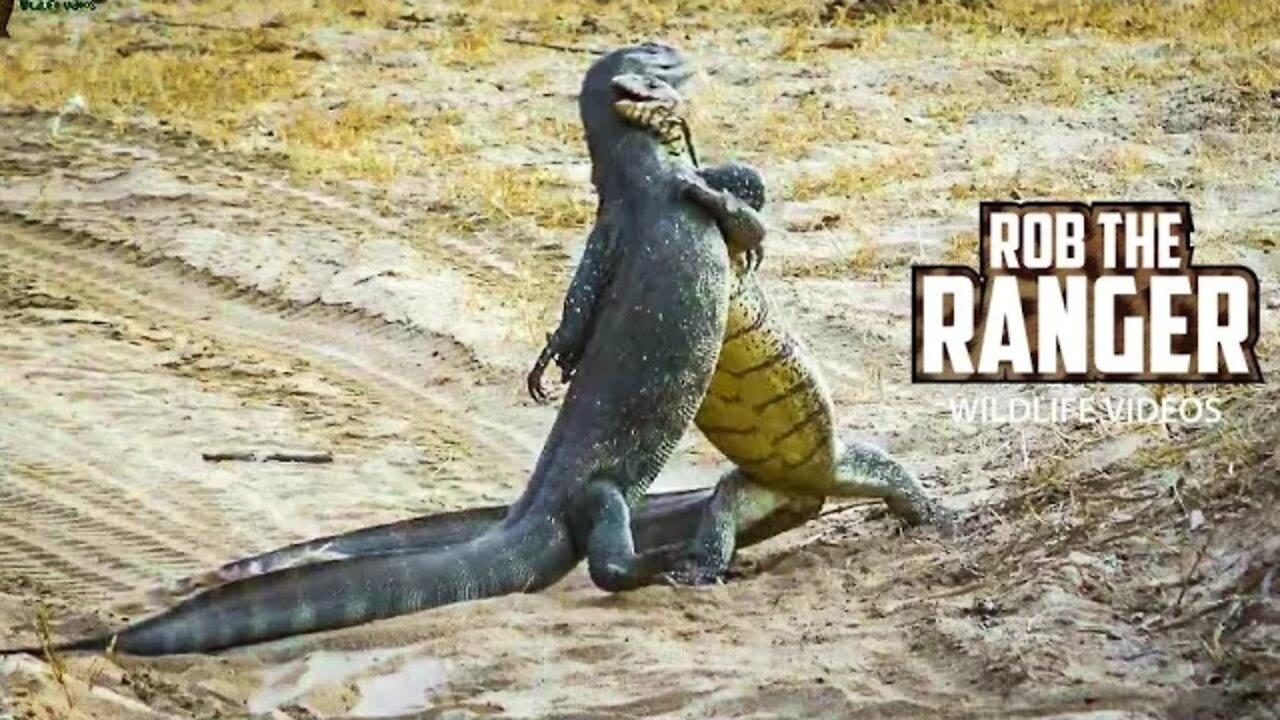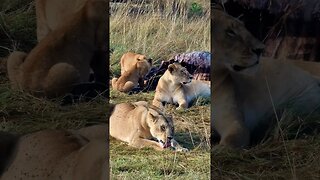Premium Only Content

Godzilla Fight? | Battle Of The Monitor Lizards
This battle of the monitor lizards is perhaps what it would look like if two variants of Godzilla fight!
Two nile monitor lizards (water leguaan, sometimes erroneously called a water monitor) fighting close to the river. Monitor lizards battle like this for territory and females.
Subscribe: https://bit.ly/30a0IRM | Merch: http://teespring.com/stores/robtheranger
Watch the newest videos: https://www.youtube.com/playlist?list=PLLLkJbMHt1booI-NVZ7lZxheEp8UMFRYE
Follow Rob The Ranger:
TWITTER: http://goo.gl/U8IQGf
INSTAGRAM: https://instagram.com/robtheranger
BLOG: http://goo.gl/yJJ3pT
FACEBOOK: http://goo.gl/M8pnJh
OFFICIAL bilibili: https://space.bilibili.com/1427022354
STEEMIT: https://steemit.com/@robtheranger
TUMBLR: http://goo.gl/qF6sNS
TIKTOK: www.tiktok.com/@robtheranger
Watch more videos!
Lions, Lions, And More Lions: https://www.youtube.com/playlist?list=PLLLkJbMHt1bpPTGnTaR798fdsHNJ7ZNGt
African Elephant (Loxodonta africana): https://.youtube.com/playlist?v=qzINZPv7PMc&list=PLLLkJbMHt1bpUo_KWtwJ3ck3Q1-xfMmkh&playnext=1
Most Popular: https://www.youtube.com/playlist?list=PLLLkJbMHt1bpQ4T4enPPMkf_5cK26Vouw
Some more info about the Nile Monitor:
The Nile monitor (Varanus niloticus) is a large member of the monitor family (Varanidae) found throughout much of Africa, but is absent from the west, where it is replaced by Varanus stellatus. Other common names include the African small-grain lizard, water leguaan or river leguaan (leguan, leguaan, and likkewaan mean monitor lizard in South African English, and can be used interchangeably)
Nile monitors can grow to about 120 to 220 cm (3 ft 11 in to 7 ft 3 in) in length, with the largest specimens attaining 244 cm (8 ft). In an average-sized specimen, the snout-to-vent length will be around 50 cm (1 ft 8 in). In body mass, adults have been reported to vary widely, one study claiming only 0.8 to 1.7 kg (1.8 to 3.7 lb), others state weights ranging from 5.9 to 15 kg (13 to 33 lb) in big monitors. Variations may be due to age or environmental conditions. Exceptionally large specimens may scale as much as 20 kg (44 lb), but this species weighs somewhat less on average than the bulkier rock monitor. They have muscular bodies, strong legs, and powerful jaws. Their teeth are sharp and pointed in juvenile animals and become blunt and peg-like in adults. They also possess sharp claws used for climbing, digging, defence, or tearing at their prey. Like all monitors, they have forked tongues, with highly developed olfactory properties. The Nile monitor has quite striking, but variable, skin patterns, as they are greyish-brown above with greenish-yellow barring on the tail and large, greenish-yellow rosette-like spots on their backs with a blackish tiny spot in the middle. Their throats and undersides are an ochre-yellow to a creamy-yellow, often with faint barring.
Their nostrils are placed high on their snouts, indicating these animals are highly aquatic. They are also excellent climbers and quick runners on land. Nile monitors feed on fish, snails, frogs, crocodile eggs and young, snakes, birds, small mammals, insects, and carrion.They are also the second largest reptile in the Nile river.
Obviously these lizards are not Godzilla as Godzilla is a mythical creature...
They are also not Water Monitors although many people in Africa call them that. The water monitor (Varanus salvator) is an Asian monitor species with a few sub-species also carrying the water monitor title, there are also Australian water monitors: Mertens' water monitor (Varanus mertensi) and Mitchell's water monitor (Varanus mitchelli )
In the Phillipines you find the marbled water monitor or Philippine water monitor (Varanus marmoratus),The Palawan water monitor, (Varanus palawanensis), and the yellow-headed water monitor (Varanus cumingi). The confusion comes from the South African name of water leguaan.
About Rob The Ranger Wildlife Videos:
The purpose of the channel is to show what it is like to experience seeing wild animals on an African safari. Nature Documentaries are often highly edited to tell a story, wildlife safaris are not, and the idea here is to show the wildlife sightings the way they were seen. Safari tours in Africa are generally suitable for all ages and this channel can be considered an educational channel about incredible nature, some scenes in the nature videos may be more graphic than people are used to but this is the reality of nature and is what you would see if you were present on such a safari in person. Safaris in Kenya, South Africa, or any other African country are an unrivalled experience for anyone with a passion for nature, wildlife photography, and travel. Hopefully the animal videos on this channel can provide a glimpse into what the nature experience is like and encourage more people to take a wildlife safari one day. Make sure to subscribe and enable ALL notifications!
-
 0:26
0:26
Rob The Ranger Wildlife Videos
1 year agoAt The Dining Table #Wildlife | #ShortsAfrica | HolidaysWithShorts
104 -
 41:26
41:26
TheTapeLibrary
16 hours ago $1.33 earnedThe Disturbing Horrors of the Trans-Allegheny Lunatic Asylum
9.13K -
 10:07
10:07
Tundra Tactical
2 hours ago $0.72 earnedTRUMP'S HUGE GUN RIGHTS MOVE!
5.21K1 -
 LIVE
LIVE
Mally_Mouse
1 hour agoSaturday Shenanigans!! - Crowd Control - Content Warning
354 watching -
 17:24
17:24
Exploring With Nug
7 hours ago $1.60 earnedScuba Diving on Underwater Cars Searching For Missing Man!
17.6K1 -
 3:06:12
3:06:12
Jewels Jones Live ®
1 day agoWASTE, FRAUD & ABUSE | A Political Rendezvous - Ep. 110
65.4K12 -
 25:11
25:11
BlackDiamondGunsandGear
3 hours agoAnderson AR-15 / Is Budget Building Trash?
13.9K8 -
 1:21:05
1:21:05
Michael Franzese
7 hours agoDemocrats MELTDOWN Over DOGE—Plus More on JFK’s Assassination | LIVE
79.4K91 -
 10:02
10:02
RTT: Guns & Gear
16 hours ago $1.59 earnedEAA Girsan Influencer X 1911 - The Cheat Code For Accuracy
18.7K -
 11:03
11:03
Degenerate Jay
3 days ago $1.33 earnedHenry Cavill James Bond Was Almost A Reality
26.5K8